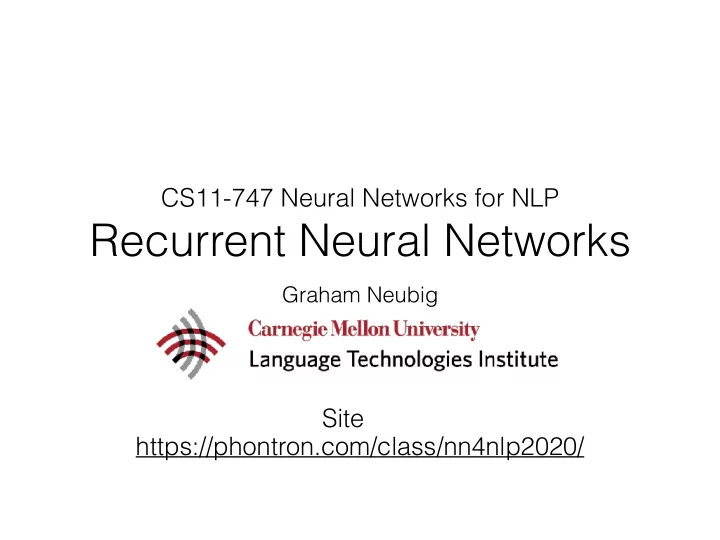

CS11-747 Neural Networks for NLP Recurrent Neural Networks Graham Neubig Site https://phontron.com/class/nn4nlp2020/
NLP and Sequential Data • NLP is full of sequential data • Words in sentences • Characters in words • Sentences in discourse • …
Long-distance Dependencies in Language • Agreement in number, gender, etc. He does not have very much confidence in himself . She does not have very much confidence in herself . • Selectional preference The reign has lasted as long as the life of the queen . The rain has lasted as long as the life of the clouds .
Can be Complicated! • What is the referent of “it”? The trophy would not fit in the brown suitcase because it was too big . Trophy The trophy would not fit in the brown suitcase because it was too small . Suitcase (from Winograd Schema Challenge: http://commonsensereasoning.org/winograd.html)
Recurrent Neural Networks (Elman 1990) • Tools to “remember” information Feed-forward NN Recurrent NN context context lookup lookup transform transform predict predict label label
Unrolling in Time • What does processing a sequence look like? I hate this movie RNN RNN RNN RNN predict predict predict predict label label label label
Training RNNs I hate this movie RNN RNN RNN RNN predict predict predict predict prediction 1 prediction 2 prediction 3 prediction 4 loss 1 loss 2 loss 3 loss 4 label 1 label 2 label 3 label 4 total loss sum
RNN Training • The unrolled graph is a well-formed (DAG) computation graph—we can run backprop sum total loss • Parameters are tied across time, derivatives are aggregated across all time steps • This is historically called “backpropagation through time” (BPTT)
Parameter Tying Parameters are shared! Derivatives are accumulated. I hate this movie RNN RNN RNN RNN predict predict predict predict prediction 1 prediction 2 prediction 3 prediction 4 loss 1 loss 2 loss 3 loss 4 label 1 label 2 label 3 label 4 total loss sum
Applications of RNNs
What Can RNNs Do? • Represent a sentence • Read whole sentence, make a prediction • Represent a context within a sentence • Read context up until that point
Representing Sentences I hate this movie RNN RNN RNN RNN predict prediction • Sentence classification • Conditioned generation • Retrieval
Representing Contexts I hate this movie RNN RNN RNN RNN predict predict predict predict label label label label • Tagging • Language Modeling • Calculating Representations for Parsing, etc.
e.g. Language Modeling <s> I hate this movie RNN RNN RNN RNN RNN predict predict predict predict predict I hate this movie </s> • Language modeling is like a tagging task, where each tag is the next word!
Bi-RNNs • A simple extension, run the RNN in both directions I hate this movie RNN RNN RNN RNN RNN RNN RNN RNN concat concat concat concat softmax softmax softmax softmax PRN VB DET NN
Code Examples sentiment-rnn.py
Vanishing Gradients
Vanishing Gradient • Gradients decrease as they get pushed back • Why? “Squashed” by non-linearities or small weights in matrices.
A Solution: Long Short-term Memory (Hochreiter and Schmidhuber 1997) • Basic idea: make additive connections between time steps • Addition does not modify the gradient, no vanishing • Gates to control the information flow
LSTM Structure
Code Examples sentiment-lstm.py lm-lstm.py
What can LSTMs Learn? (1) (Karpathy et al. 2015) • Additive connections make single nodes surprisingly interpretable
What can LSTMs Learn? (2) (Shi et al. 2016, Radford et al. 2017) Count length of sentence Sentiment
Efficiency Tricks
Handling Mini-batching • Mini-batching makes things much faster! • But mini-batching in RNNs is harder than in feed- forward networks • Each word depends on the previous word • Sequences are of various length
Mini-batching Method this is an example </s> this is another </s> </s> Padding Loss 1 1 1 1 1 � � � � � 1 1 1 1 0 Calculation Mask Take Sum (Or use DyNet automatic mini-batching, much easier but a bit slower)
Bucketing/Sorting • If we use sentences of different lengths, too much padding and sorting can result in decreased performance • To remedy this: sort sentences so similarly- lengthed sentences are in the same batch
Code Example lm-minibatch.py
Optimized Implementations of LSTMs (Appleyard 2015) • In simple implementation, still need one GPU call for each time step • For some RNN variants (e.g. LSTM) efficient full- sequence computation supported by CuDNN • Basic process: combine inputs into tensor, single GPU call combine inputs into tensor, single GPU call • Downside: significant loss of flexibility
RNN Variants
Gated Recurrent Units (Cho et al. 2014) • A simpler version that preserves the additive connections Additive or Non-linear • Note: GRUs cannot do things like simply count
Extensive Architecture Search for LSTMs (Greffen et al. 2015) • Many different types of architectures tested for LSTMs • Conclusion: basic LSTM quite good, other variants (e.g. coupled input/ forget gates) reasonable
Handling Long Sequences
Handling Long Sequences • Sometimes we would like to capture long-term dependencies over long sequences • e.g. words in full documents • However, this may not fit on (GPU) memory
Truncated BPTT • Backprop over shorter segments, initialize w/ the state from the previous segment 1st Pass I hate this movie RNN RNN RNN RNN 2nd Pass state only, no backprop It is so bad RNN RNN RNN RNN
Questions?
Recommend
More recommend